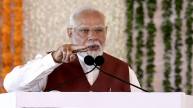Canada is hosting the three-day G7 (Group of Seven) Summit, which concludes on June 17. The summit aims to bring together the leaders of some of the world’s most advanced economies, including the United States, France, the United Kingdom, Italy, Germany, Canada, Japan, and the European Union.
This summit will also see the participation of representatives from international organizations like the United Nations, World Bank, and International Monetary Fund (IMF). This time, the G7 meeting is being held in Kananaskis, Alberta, a remote town in the foothills of the Canadian Rockies. Canada is holding the group’s presidency for the seventh time.
Canadian Prime Minister Mark Carney has invited several non-G7 leaders as guests, including Indian Prime Minister Narendra Modi.
The members of G7 include Canada, France, Germany, Italy, Japan, the United Kingdom, and the US. The group has a combined GDP of $47.33 trillion, accounting for only 44.58% of global GDP.
Moreover, the population this group represents is far lower. According to Worldometer, the G7 countries have a combined population of 789.92 million, accounting for less than 10% of the global population. In my opinion, what makes the G7 Summit inconsequential is the notable absence of two of the world’s top five economies and a significant military power.
To maintain its significance, the G7 now needs to evolve into a G10, including China, India, and Russia as members.
The G7, also known as the world’s first “World Economic Summit,” was launched in 1975 by French President Valéry Giscard d’Estaing and German Chancellor Helmut Schmidt. Initially formed as the Group of Six, it included France, Italy, Japan, the UK, the US, and West Germany. Canada joined the elite group the following year, making it the G7.
In 1980, G7 countries accounted for 13% of the global population and 62% of the world’s nominal GDP. Later, the group evolved into the G8 when Russia joined it in 1998. Russia was effectively expelled from the group in 2014 following its annexation of Crimea, making it the G7 again.
Population
The G7 focuses on key areas such as energy policy, international security, and global economic management, playing a leading role in addressing these critical issues worldwide. Now, here comes the miss. As per Worldometer, the global population stands at 8.23 billion. India and China, with 1.46 billion and 1.42 billion people respectively, account for 35% of the world’s population combined.
Furthermore, Russia has a population of 144 million, which would be second only to the US in the current G7 structure. Together, India, Russia, and China represent 36.70% of the world’s total population.
The question is that, how can the G7 effectively discuss global issues when it excludes two countries that account for 35% of the world’s population?
Economy
According to the Worldometer, the total GDP in the world is $106.17 trillion (nominal, 2023). The G7 represents only $47.33 trillion (44.58%) of the global GDP, and even that is largely driven by the US, which accounts for 58.56% of the group’s total GDP.
China has a total GDP of $17.795 trillion, India has a total GDP of $3.568 trillion, and Russia has a total GDP of $2.021 trillion. Together, they make up a combined GDP of $23.384 trillion, which accounts for 22.03% of the total global GDP. Moreover, China is the world’s second-largest economy, only behind the US, and India is currently the fifth-largest economy of the world, placing it above four nations in the current G7 structure.
Another economic parameter to look for is the debt-to-GDP ratio, which is a country’s total debt to its GDP. As per the International Monetary Fund’s 2023 estimates, Japan leads the G7 group with a staggering debt-to-GDP ratio of 249.67%, followed by Italy at 134.79%, and the United States at 123.01%. Other members also show significant debt burdens: France (110.64%), Canada (107.49%), and the United Kingdom (101.15%), while Germany maintains the lowest ratio in the group at 62.66%.
Meanwhile, India has a debt-to-GDP ratio of 83.02%, China is at 84.38%, and Russia is at 19.55%, which is considerably lower than that of the ‘elite countries’ in the G7 group.
Notably, more debt-to-GDP ratio raises concerns over long-term fiscal sustainability and the ability of advanced economies to navigate future economic shocks.
One reason that comes to my mind when I try to understand why the three major countries of the world are not part of the G7 is that it appears to be an attempt by America to snub influential nations from the so-called elite group in order to maintain its edge.
Military Power
Let’s compare the G7 countries with India, China, and Russia in terms of military power in 2025. I will refer to the Global Firepower ranking, which uses over 60 individual factors to determine a nation’s PowerIndex (‘PwrIndx’) score, with categories ranging from the quantity of military units and financial standing to logistical capabilities and geography.
G7 Countries
| Country | Rank | PowerIndex | Military Personnel | Total Aircraft | Total Tanks |
|---|---|---|---|---|---|
| United States | 1 | 0.0744 | 21,27,500 | 13,043 | 4,640 |
| United Kingdom | 6 | 0.1785 | 11,08,860 | 631 | 227 |
| France | 7 | 0.1878 | 3,76,000 | 976 | 215 |
| Japan | 8 | 0.1839 | 3,28,150 | 1,443 | 521 |
| Italy | 10 | 0.2164 | 2,89,000 | 729 | 200 |
| Germany | 14 | 0.2601 | 62,800 | 584 | 296 |
| Canada | 28 | 0.5179 | 68,000 | 351 | 74 |
India, China And Russia
| Country | Rank | PowerIndex | Military Personnel | Total Aircraft | Total Tanks |
|---|---|---|---|---|---|
| Russia | 2 | 0.0788 | 35,70,000 | 4,292 | 5,750 |
| China | 3 | 0.0788 | 31,70,000 | 3,309 | 6,800 |
| India | 4 | 0.1184 | 51,37,550 | 2,229 | 4,201 |
The data highlights that the G7 excludes three of the world’s top four military powers, making the so-called elite group insignificant.
When it comes to military spending, the United States leads with $895 billion, followed by China at $266.8 billion, Russia at $126 billion, and India at $75 billion. Moreover, the United Kingdom spends $71.5 billion, Japan $57 billion, France $55 billion, Germany $50 billion, Canada $41 billion and Italy $30.8 billion on their militaries.
Excluding the US, the other six G7 countries collectively spend $305.3 billion on their military, which falls significantly short of the $467.8 billion spent by China, Russia, and India combined. India, Russia, and China are among the top four countries globally in terms of military spending.
Nuclear Power
Among the G7 countries, only 3 (the US, UK and France) are the nuclear-powered states. In the list of nuclear-powered states, Russia has the highest number of nuclear weapons. India and China are also the nuclear-powered states, but still India, Russia, and China are not the members of G7.
What If The G7 Includes India, China And Russia?
Including India, China, and Russia in the influential Group will make G7 (or the potential G10) significant and perhaps the most consequential economic forum.
Currently, the G7 nations have a combined GDP of $47.33 trillion, representing just 44.58% of the global total. By including India, China, and Russia, an additional $23.384 trillion would be added, raising the group’s total GDP to $70.714 trillion, equivalent to 66.61% of the global GDP.
Expanding the G7 to G10 would include all the world’s top 5 economies, up from the current 3.
In terms of the debt-to-GDP ratio, India, China, and Russia have performed significantly better than most of the G7 countries, presenting a more ideal scenario.
Moreover, as of now, the G7 represents fewer than 10% (789.92 million) of the world’s population. In the case of a G10, the group’s combined population would be 3.81 billion, or 46.29% of the total global population.
Adding to the G7 to make it G10 would bring in the world’s two most populous countries. Currently, the G7 only includes one of the top 5 most populous countries, the US.
The G7 countries currently have a total of 43,60,310 military personnel, whereas India alone has 51,37,550. Likewise, the G10 would have 1,62,37,860 military personnel. The G7 countries cumulatively possess 17,757 aircraft, whereas expanding to a G10 would increase this number to 27,587.
Talking about tanks, the G7 currently have 6,173 tanks, whereas China alone has 6,800 tanks.
The G10 would comprise 4 of the world’s 5 top military powers, a significant increase from the current 1 (the US) represented in the G7.
Furthermore, the US, UK, and France are the only 3 G7 countries that have nuclear weapons. G10 would raise this number to 6. Notably, there are currently 9 countries in the world that possess nuclear weapons.
Power Balancing
Including India, China, and Russia in the elite group of 7 would turn it into a group of 10 and could potentially curb US dominance within the group. Reducing US dominance would make the group more balanced and transparent, strengthening the voice of other member states and leading to more solid and unbiased consensus on global issues and economic developments.
How Will The Power Be Balanced?
- The US ($27.721 trillion) is currently the largest economy in the G7, and the inclusion of India, China, and Russia won’t affect its rank. However, the US would be closely followed by China ($17.795 trillion), reducing its economic dominance. In the current G7 structure, Germany is the second-largest economy, but it lags significantly behind at $4.526 trillion.
- The US currently accounts for 58.56% of the G7’s total GDP, but in G10, it will only account for 39.2% of the group total GDP.
- The US is currently the most populous country in the G7, but in the proposed G10, India would become the most populous, followed by China in second place and the US in third.
- Moreover, the US will remain the most powerful military with the highest number of aircraft but will lose its dominance in the total number of tanks, with China taking the top position and India the second. The US will also lose its position in terms of military personnel, dropping to fourth place, with India, Russia, and China occupying the top three positions, respectively.
- The US (5,277) holds the largest number of nuclear weapons among G7 countries. However, in the proposed G10, Russia (5,449) would surpass the US to become the member state with the most nuclear weapons.
The US Stance And Concern For India
The elite group of seven has always been reluctant to include more countries, despite its declining relevance. However, this time, there is a good news for Russia and China. During the current G7 summit, US President Donald Trump supported Russia’s return to the G7/G8 and criticized former US President Barack Obama and former Canadian Prime Minister Justin Trudeau for pushing the country out of the group.
Moreover, the US President also hinted China’s inclusion into the elite group. When asked about China joining the G7, Trump said, “It’s not a bad idea. I don’t mind that if somebody wants to see just China coming in.”
However, what’s worrisome for India is that no such statements were made in its regard by any world leader. The US, too, did not talk about India’s entry into the group, despite the so-called close friendship between President Trump and Prime Minister Modi.
Conclusion
The G7, while historically influential, no longer reflects global economic and geopolitical realities. With rising powers like India, China, and Russia excluded, its credibility as a truly global forum is diminishing. Expanding to a G10 would make the group more representative, balanced, and effective in addressing worldwide challenges. While there’s openness toward Russia and China, the lack of support for India’s inclusion highlights a strategic oversight that risks undermining the group’s relevance in a multipolar world.











